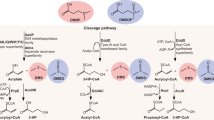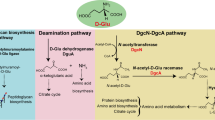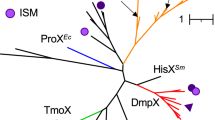Abstract
Ruegeria pomeroyi DSS-3 is a model Roseobacter marine bacterium, particularly regarding its catabolism of dimethylsulfoniopropionate (DMSP), an abundant anti-stress molecule made by marine phytoplankton. We found a novel gene, dddW, which encodes a DMSP lyase that cleaves DMSP into acrylate plus the environmentally important volatile dimethyl sulfide (DMS). Mutations in dddW reduced, but did not abolish DMS production. Transcription of dddW was greatly enhanced by pre-growth of cells with DMSP, via a LysR-type regulator. Close DddW homologs occur in only one other Roseobacter species, and there are no close homologs and only a few related sequences in metagenomes of marine bacteria. In addition to DddW, R. pomeroyi DSS-3 had been shown to have two other, different, DMSP lyases, DddP and DddQ, plus an enzyme that demethylates DMSP, emphasizing the importance of this substrate for this model bacterium.
Similar content being viewed by others
Main
A feature of the abundant marine α-proteobacteria known as the Roseobacters is that they catabolize dimethylsulfoniopropionate (DMSP), an anti-stress molecule made in massive amounts (∼109 tons annually) by marine phytoplankton (Kettle et al., 1999). Strikingly, several Roseobacter strains degrade DMSP by more than one mechanism, either demethylating it or cleaving it, in a process that releases the volatile dimethyl sulfide (DMS; González et al., 1999; Newton et al., 2010). DMS has diverse environmental effects; it is a chemoattractant for different marine animals (Seymour et al., 2010) and its oxidation products form cloud condensation nuclei, affecting levels of reflected sunlight (Charlson et al., 1987).
Recent genetic analyses reveal the molecular basis of this metabolic flexibility, as several different enzymes can act on the DMSP substrate. Indeed, some individual bacterial strains have multiple ways to catabolize DMSP. For example, Ruegeria pomeroyi DSS-3 contains DmdA, the DMSP demethylase (Howard et al., 2006), plus two genes, dddQ and dddP, that encode DMSP lyases that cleave DMSP into DMS plus acrylate, although they are in wholly different polypeptide families (Todd et al., 2009, 2011; Kirkwood et al., 2010).
In a microarray study (MK, unpublished) of R. pomeroyi genes whose expression was affected by growth in media with 5 mM DMSP, one of the most markedly induced (∼37-fold) was SPO0453, as independently noted by Rinta-Kanto et al. (2011). The product of this gene, which we term dddW, contained a predicted cupin pocket (Figure 1), a widely distributed motif found in many enzymes, where it forms the active site (Dunwell et al., 2004). Such a feature also occurs in the DMSP lyases DddQ (Todd et al., 2011) and DddL (Curson et al., 2008), but both of these are larger (∼22 kDa and ∼26 kDa, respectively) than DddW (16.1 kDa), and share no other significant sequence or predicted structural similarities.
Comparison of cupin-like regions of DddL, DddQ and DddW polypeptides. The sequences of the predicted cupin-like motifs of the DddW polypeptides of Ruegeria pomeroyi DSS-3 and Roseobacter sp. MED193 were compared with those of the DddL DMSP lyases of Sulfitobacter sp. EE-36 and Rhodobacter sphaeroides 2.4.1 and the DddQ-type lyases of Ruegeria pomeroyi DSS-3 and Roseovarius nubinhibens ISM. Corresponding gene numbers are underlined. The highly conserved residues in cupins (Dunwell et al., 2004) are indicated in single-letter code above the comparisons. Residues highlighted in black, dark gray or light gray indicate 100%, >80% or >60% conservation, respectively.
To study dddW, it was amplified from R. pomeroyi genomic DNA, then cloned into the expression vector pET21a. Escherichia coli transformants containing the resulting recombinant plasmid produced DMS at a rate of 35 pmol μg protein−1 min−1 when the substrate DMSP (5 mM) was added to cell-free extracts, compared with a background value in E. coli itself of 0.02 pmol μg protein−1 min−1 (Supplementary methods). This value obtained for the cloned dddW is similar to that obtained when the cloned dddP and dddL genes of R. pomeroyi and Rhodobacter sphaeroides, respectively, were examined in the same manner (Curson et al., 2008; Todd et al., 2011). On feeding [1-14C]DMSP to cell-free extracts of E. coli with cloned dddW, 100% of the 14C was converted to labeled acrylate after 1-h incubation, confirming that DddW is a bona fide ‘DMSP lyase’.
To determine its role in R. pomeroyi, we made an insertional mutation into dddW, using the suicide plasmid pBIO1879 (Supplementary methods). The DddW− mutant produced DMS from DMSP at a rate ∼50% that of wild type, an effect smaller than that seen in a DddQ− mutant, but similar to that caused by a mutation in dddP (Todd et al., 2009, 2011). Thus, DddW, like the other two lyases, contributes to DMSP catabolism in R. pomeroyi DSS-3.
To further examine DMSP-dependent regulation of dddW expression, we cloned its promoter region into the wide host-range promoter-probe vector pBIO1878, upstream of its lacZ reporter. The resulting plasmid, pBIO1945, was mobilized into wild-type R. pomeroyi and the transconjugant assayed for β-galactosidase after growth in minimal media that either contained or lacked 5 mM DMSP (Supplementary methods). The dddW–lacZ fusion was induced, 10-fold, in the +DMSP media.
Separated by 94 base pairs from the start of dddW is a gene, SPO0454, which encodes a predicted LysR-type transcriptional regulator. We attempted to mutate SPO0454 using the same approach as for the insertion into dddW, but this was unsuccessful. This may be due to the polar effects of insertions in SPO0454 on the expression of a downstream gene, SPO0455, which is predicted to be co-transcribed with SPO0454 and which encodes a potentially essential lysyl-tRNA synthetase. We therefore adopted a different approach to show that SPO0454 regulated dddW. First, we conjugated the dddW–lacZ fusion plasmid pBIO1945 into the α-proteobacterium Rhizobium leguminosarum, which effectively expresses heterologous genes (Young et al., 2006). Into this strain was then transferred pBIO1946, containing intact SPO0454 including its native promoter, cloned in the wide host-range plasmid pOT2. We then measured the effects of pre-growth in DMSP on dddW–lacZ expression (as β-galactosidase activity) in R. leguminosarum/pBIO1945 that either contained or lacked the cloned SPO0454 gene in pBIO1946. In R. leguminosarum itself, dddW–lacZ was expressed constitutively at a low level in both growth media. However, the presence of SPO0454 increased β-galactosidase activity ∼5-fold, but only when cells were pre-grown with DMSP (Figure 2). Thus, SPO0454 encodes a transcriptional activator that responds to DMSP. Furthermore, SPO0454 was auto-regulatory, like other lysR-type regulatory genes (Maddocks and Oyston, 2008). This was shown by the behavior in R. leguminosarum of an SPO0454–lacZ fusion plasmid, termed pBIO1947, that we constructed. This expressed β-galactosidase constitutively in R. leguminosarum itself, but was repressed ∼5-fold by introducing SPO0454, cloned in pBIO1946, irrespective of whether DMSP was in the medium or not (Figure 2).
Effects of DMSP and the regulatory SPO0454 gene on the expression of the dddW and SPO0454 genes of R. pomeroyi DSS-3. Cultures of Rhizobium leguminosarum strain 3841 (a, b) or of Ruegeria pomeroyi DSS-3 (c) and containing either the dddW–lacZ fusion plasmid pBIO1945 (a, c) or the SPO0454–lacZ fusion plasmid pBIO1947 (b, c) were grown in minimal medium that either lacked (gray columns) or contained (black columns) 5 mM DMSP. These strains were assayed in triplicate for β-galactosidase activities, whose values with standard errors are shown in Miller Units. In the Rhizobium background, some of the strains with the fusion plasmids also contained pBIO1946, in which the SPO0454 gene is cloned in the vector pOT2, as indicated.
In addition to its DmdA demethylase (Howard et al., 2006), R. pomeroyi DSS-3, remarkably, has three different DMSP lyases, the previously identified DddP and DddQ, and the newly discovered DddW. All these lyases function in R. pomeroyi, as mutations in the corresponding genes affect its DMS-emitting phenotype. As judged by the individual mutant phenotypes, in our laboratory conditions, DddW appears to contribute about the same to the flux into DMS production as DddP, but less than DddQ.
Currently, the only other bacterium with a close DddW homolog (65% identical) is Roseobacter sp. MED193, whose dddW is also transcribed divergently from an SPO0454 homolog. More poorly conserved homologs (∼40% identical to the DddW of R. pomeroyi DSS-3) were found in two other Roseobacters, namely Rhodobacterales bacterium HTCC2083 and Citreicella sp. SE45; nevertheless, DddW is rarer among the deduced proteomes of Roseobacters and other marine bacteria than other Ddd polypeptides (Newton et al., 2010). Consistent with this, there are no very close DddW homologs in marine metagenomic sequences (surveyed in the CAMERA portal at http://camera.calit2.net/), most notably those in the Global Ocean Sampling (GOS) described by Rusch et al. (2007). However, four sequences in the GOS had deduced polypeptides with some similarity to DddW (40–50% identical; probability <e−22). These were all from the hypersaline lagoon site at Punta Cormorant in Galapagos, the same site at which homologs of a different lyase, DddL, were seen (Curson et al., 2008). However, the ecological significance, if any, of this is unknown. Indeed, given the relatively low level identity of the metagenomic reads and DddW itself, it remains to be confirmed that these correspond to functional DMSP lyases.
Other Roseobacter strains also have multiple DMSP lyases—Roseovarius nubinhibens, for example, has two versions of DddQ plus DddP (Todd et al., 2009, 2011). It will be interesting to know if these different enzymes, plus the DmdA demethylase, are particularly adapted to specific environments that vary in the availability of DMSP substrate (see, for example, González et al., 1999) or other factors, such as temperature, pH or the availability of other nutrients. Furthermore, other bacteria have yet other classes of enzymes that release DMS from DMSP (Todd et al., 2007; Curson et al., 2008, 2011), further emphasizing the genetic diversity of this important environmental biotransformation.
References
Charlson RJ, Lovelock JE, Andreae MO, Warren SG . (1987). Oceanic phytoplankton, atmospheric sulphur, cloud albedo and climate. Nature 326: 655–661.
Curson ARJ, Sullivan MJ, Todd JD, Johnston AWB . (2011). DddY, a periplasmic dimethylsulfoniopropionate lyase found in taxonomically diverse species of proteobacteria. ISME J; e-pub ahead of print 20 January 2011.
Curson ARJ, Rogers R, Todd JD, Brearley CA, Johnston AWB . (2008). Molecular genetic analysis of a dimethylsulfoniopropionate lyase that liberates the climate-changing gas dimethylsulfide in several marine alpha-proteobacteria and Rhodobacter sphaeroides. Environ Microbiol 10: 757–767.
Dunwell JM, Purvis A, Khuri S . (2004). Cupins: the most functionally diverse protein superfamily? Phytochemistry 65: 7–17.
González JM, Kiene RP, Moran MA . (1999). Transformation of sulfur compounds by an abundant lineage of marine bacteria in the α-subclass of the class Proteobacteria. Appl Environ Microbiol 65: 3810–3819.
Howard EC, Henriksen JR, Buchan A, Reisch CR, Bürgmann H, Welsh R et al. (2006). Bacterial taxa that limit sulfur flux from the ocean. Science 314: 649–652.
Kettle AJ, Andreae MO, Amouroux D, Andreae TW, Bates TS, Berresheim H et al. (1999). A global database of sea surface dimethylsulfide (DMS) measurements and a procedure to predict sea surface DMS as a function of latitude, longitude, and month. Glob Biogeochem Cycles 13: 399–444.
Kirkwood M, Le Brun NE, Todd JD, Johnston AWB . (2010). The dddP gene of Roseovarius nubinhibens encodes a novel lyase that cleaves dimethylsulfoniopropionate into acrylate plus dimethyl sulfide. Microbiol 156: 1900–1906.
Maddocks SE, Oyston PCF . (2008). Structure and function of the LysR-type transcriptional regulator (LTTR) family proteins. Microbiol 154: 3609–3623.
Newton RJ, Griffin LE, Bowles KM, Meile C, Gifford S, Givens CE et al. (2010). Genome characteristics of a generalist marine bacterial lineage. ISME J 4: 784–798.
Rinta-Kanto JM, Bürgmann H, Gifford SM, Sun S, Sharma S, Del Valle DA et al. (2011). Analysis of sulfur-related transcription by Roseobacter communities using a taxon-specific functional gene microarray. Environ Microbiol 13: 453–467.
Rusch DB, Halpern AL, Sutton G, Heidelberg KB, Williamson S, Yooseph S et al. (2007). The Sorcerer II Global Ocean Sampling Expedition: northwest Atlantic through eastern tropical Pacific. PLoS Biol 5: e77.
Seymour JR, Simó R, Ahmed T, Stocker R . (2010). Chemoattraction to dimethylsulfoniopropionate throughout the marine microbial food web. Science 329: 342–345.
Todd JD, Curson ARJ, Kirkwood M, Sullivan MJ, Green RT, Johnston AWB . (2011). DddQ, a novel, cupin-containing, dimethylsulfoniopropionate lyase in marine roseobacters and in uncultured marine bacteria. Environ Microbiol 13: 427–438.
Todd JD, Curson ARJ, Dupont CL, Nicholson P, Johnston AWB . (2009). The dddP gene, encoding a novel enzyme that converts dimethylsulfoniopropionate into dimethyl sulfide, is widespread in ocean metagenomes and marine bacteria and also occurs in some Ascomycete fungi. Environ Microbiol 11: 1376–1385.
Todd JD, Rogers R, Li YG, Wexler M, Bond PL, Sun L et al. (2007). Structural and regulatory genes required to make the gas dimethyl sulfide in bacteria. Science 315: 666–669.
Young JPW, Crossman LC, Johnston AWB, Thomson NR, Ghazoui ZF, Hull KH et al. (2006). The genome of Rhizobium leguminosarum has recognizable core and accessory components. Genome Biol 7: R34.
Acknowledgements
This work was funded by the BBSRC and the NERC of the United Kingdom. We are grateful to Pamela Wells for technical support and to Andrew Curson and Rob Green for helpful discussions.
Author information
Authors and Affiliations
Corresponding author
Additional information
Supplementary Information accompanies the paper on The ISME Journal website
Supplementary information
Rights and permissions
About this article
Cite this article
Todd, J., Kirkwood, M., Newton-Payne, S. et al. DddW, a third DMSP lyase in a model Roseobacter marine bacterium, Ruegeria pomeroyi DSS-3. ISME J 6, 223–226 (2012). https://doi.org/10.1038/ismej.2011.79
Received:
Revised:
Accepted:
Published:
Issue Date:
DOI: https://doi.org/10.1038/ismej.2011.79
Keywords
This article is cited by
-
Ubiquitous occurrence of a dimethylsulfoniopropionate ABC transporter in abundant marine bacteria
The ISME Journal (2023)
-
The biogeochemistry of marine dimethylsulfide
Nature Reviews Earth & Environment (2023)
-
Oceanospirillales containing the DMSP lyase DddD are key utilisers of carbon from DMSP in coastal seawater
Microbiome (2022)
-
Biogeographical and seasonal dynamics of the marine Roseobacter community and ecological links to DMSP-producing phytoplankton
ISME Communications (2022)
-
Transcriptome analysis of Antarctic Rhodococcus sp. NJ-530 in the response to dimethylsulfoniopropionate
Polar Biology (2022)





